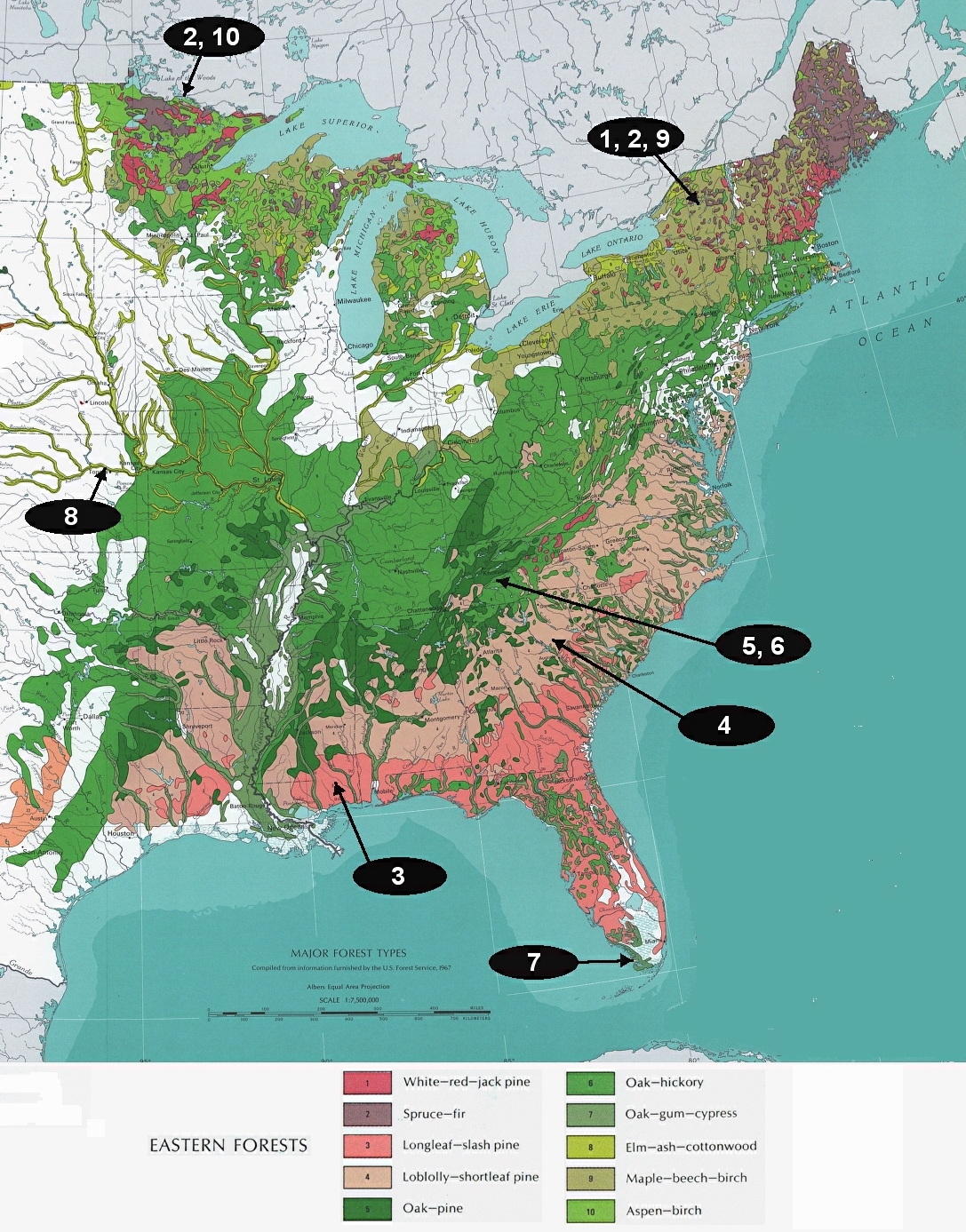
DECIDUOUS FORESTS
Eastern U.S. Forests
Chapter Outline
- Introduction
- Spruce/Fir
- Aspen/Birch
- White/Red/Jack Pine
- Maple/Beech/Birch
- Elm/Ash/Cottonwood
- Oak/Hickory
- Oak/Pine
- Loblolly/Shortleaf Pine
- Longleaf/Slash Pine
- Oak/Gum/Cypress
Links to external sites will appear in pop-up windows.
Figure 1 by Western Regional Climate Center
Figure 2 was adapted from a map in the National Atlas
There is no one forest that can be considered the typical eastern forest. At least ten different types of eastern forests have been described. However, eastern forests tend to be distinguished from western forests based on one dominant factor: precipitation.
 Figure 1 - Annual Average Precipitation in the United States. Click for an enlarged view. |
Eastern forests also tend to be dominated by trees and other plants that lose their leaves in Autumn. These types of plants are called deciduous, and eastern forests are often called deciduous forests. A classic example of a deciduous forest is Great Smoky Mountains National Park. Here two of the ten forest types dominate: the Oak Hickory and Oak-Pine forests. These two forest types combine to be the dominant one in the eastern U.S., ranging from Massachusetts to Iowa and Texas to Georgia (the dominant shades of green on Figure 2).
 Figure 2 - Forest Types of the eastern United States. Click for an enlarged view. |
Speaking of the upper midwest, northern parts of Michigan, Wisconsin and Minnesota are the places where you will find another rare forest type: the Aspen-Birch forest. In the area around Voyageurs National Park, on Minnesota's Canadian border, the Aspen-Birch forest is mixed with the Spruce-Fir and White-Red-Jack Pine forests similar to those in the Adirondacks.
In a strip along the southern and eastern boundary of the dominant oak forests of the east is the Loblolly-Shortleaf Pine forest type. These forests form an arc from New Jersey down through Georgia into Louisiana and Arkansas (see Figure 2). Sumter National Forest in South Carolina is a good spot for observing this forest type.
South of the Loblolly Pine forest is the Longleaf-Slash Pine forest. This forest type is supported by some of the highest rainfall amounts in the east (see Figure 1). Desoto National Forest in southern Mississippi is a good representaive of the "pineywoods."
In Florida's extreme south, America's subtropical climate can be found. The fact that certain areas there have never had temperatures drop below freezing has influenced the plant communities. Oak-Gum-Cypress forests, similar to those in southern Louisiana, can be found there, but there are also many plants that are found nowhere else. The hardwood hammocks of southern Florida and the Keys support more species of trees and shrubs than any other forest type in the United States.
The eastern forests start to give way to the grasslands of the middle of the country at about the Missouri/Kansas border. However, one forest type persists well into the prairie: the Elm-Ash-Cotonwood forest. These forests follow the river corridors into the plains. The abundance of water found along the rivers is enough to support forests of these tree types where the climate would normally dictate grasslands.
Maps/Links:
- Oak/Gum/Cypress [ Zoom ] - Okefenokee Swamp, Atchafalaya
- Longleaf/Slash Pine [ Zoom ] - Okefenokee Swamp, DeSoto NF
- Loblolly/Shortleaf Pine [ Zoom ] - Sumter National Forest, Oconee NF
- Oak/Pine [ Zoom ] - Mammoth Cave, Smoky Mountains
- Oak/Hickory [ Zoom ] - Smoky Mountains, Mammoth Cave
- Elm/Ash/Cottonwood [ Zoom 1 ] [ Zoom 2 ] - Platte River, Fort Custer State Recreation Area
- Maple/Beech/Birch [ Zoom ] - Adirondacks
- White/Red/Jack Pine [ Zoom ] - Hiawatha National Forest (south of Whitefish Bay), Hartwick Pines SP
- Aspen/Birch [ Zoom ] - Superior National Forest (Rte. 1, near Isabella, Minnesota), Voyageurs
- Spruce/Fir [ Zoom ] - Pukaskwa, Voyageurs
| [ Previous Page ] | [ Next Page ] |